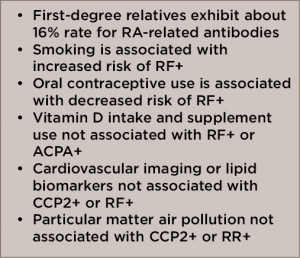In his talk, Dr. Holers described ongoing research examining the pathologic process at RA initiation—that is, what is happening in the body prior to a patient exhibiting synovitis. Table 1 highlights key findings from military cohort studies that show which patients have preclinical disease or are at high risk of developing RA.1,2
New Understanding of How RA Begins: From Bad Luck to Causal Pathways

Dr. Matteson
Saying that most clinicians traditionally preferred to view the initiation of RA as due to bad luck or some uncertain process (stochastic model of disease), Dr. Holers said that the weight of the evidence is now leaning toward a deterministic model in which the disease is thought to be caused by specific and definable environmental and genetic influences.
Results from epidemiological studies of persons at high-risk of developing RA or those with preclinical disease support this, he said. Table 2 lists a number of findings from these studies.3-7
Of particular interest, he said, is evidence showing that omega-3 fatty acids may be protective against the development of RA. He described data showing that an increasing percentage of omega-3 fatty acids in red blood cells is inversely related to anti-CCP2 and lower odds of RF positivity in shared epitope positive individuals who have not yet developed clinically apparent disease.8,9

(click for larger image)
Table 2: Results from Epidemiological Studies of Factors Associated with RA
Key: RA, rheumatoid arthritis; RF, rheumatoid factor; ACPA, anti-citrullinated protein antibody
Dr. Holers emphasized that these epidemiological findings suggest that smoking, contraceptive use and omega-3 fatty acids have an effect on pre-clinical autoimmunity. Unlike these factors, the effects of pollution and development of RA comorbidities do not appear until later in the disease process when initial signs and symptoms of RA appear.
Lung: Primary Site of Disease Initiation?
Emerging from these studies on the multiple changes occurring in pre-clinical disease is an evolving understanding of the involvement of the lungs in RA. Although largely seen as a secondary outcome associated with joint disease, evidence now suggests that the lungs may be affected before the joints and be a primary site of disease initiation.
“The lungs are an area of increasing focus for RA pathogenesis research,” said Dr. Holers. “Think about how big the lung’s surface area is. If you stretch out all the tissue, it’s like a football field. The lungs have so much exposure to various factors in the environment, like viruses and bacteria.”


